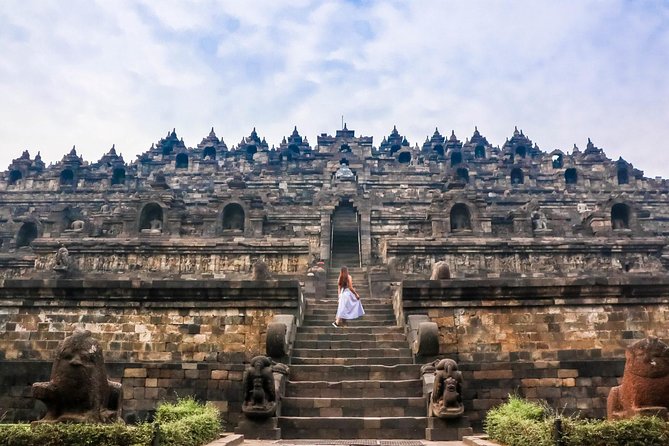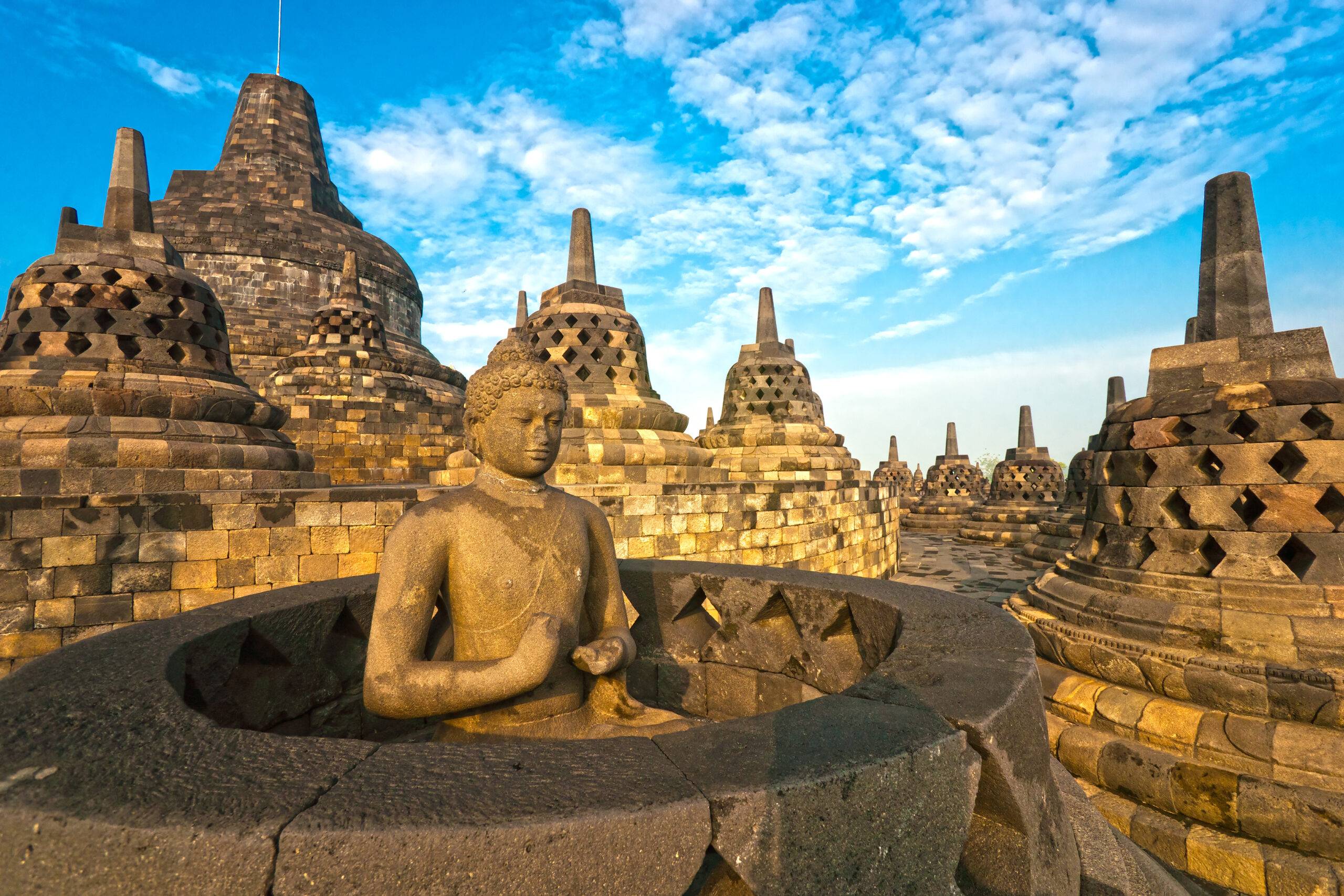Imagine standing on an ancient stone terrace, the first rays of dawn painting the sky in hues of tangerine and rose. Below you, a mist-shrouded jungle slowly awakens, and in the distance, volcanic peaks stand guard. Before you, a monumental structure rises, an architectural symphony of grey volcanic stone, adorned with thousands of intricate carvings and serene Buddha statues. This isn’t a dream; this is Borobudur, Indonesia’s colossal Buddhist temple, a UNESCO World Heritage site that beckons travelers with its profound beauty and spiritual resonance. More than just a magnificent ruin, a visit here is an immersive journey into Javanese history and spirituality, making it crucial to understand Borobudur temple local customs to know for a truly enriching and respectful experience.
Introduction: Where Ancient Whispers Meet Modern Wonder
Borobudur isn’t merely a temple; it’s a three-dimensional mandala, a spiritual blueprint guiding pilgrims upwards from the earthly realm to Nirvana. Built in the 9th century, this colossal monument lay hidden under layers of volcanic ash and jungle growth for centuries before its rediscovery. Today, it stands as a testament to human ingenuity and devotion, drawing visitors from across the globe. The air here, especially at sunrise, hums with a quiet energy, a palpable sense of history and reverence. It’s a place that transcends mere sightseeing, offering a deep dive into Javanese culture, artistry, and a spiritual journey etched in stone. Understanding the nuances of local customs ensures your visit is not only memorable but also deeply respectful of this sacred site and its surrounding communities.
Highlights: A Tapestry of Culture and Serenity
The atmosphere at Borobudur is utterly captivating. As you ascend its nine platforms, each level unfolds a new narrative through over 2,672 bas-relief panels, depicting Buddhist cosmology, the life of Buddha, and Jataka tales. These intricate carvings are a history book in stone, offering insights into ancient Javanese life, fashion, and philosophy. The natural scenery surrounding the temple is equally breathtaking: lush, emerald-green rice paddies stretch to the horizon, framed by the majestic silhouettes of Mount Merapi and Mount Sumbing, often wreathed in soft cloud. It’s a landscape that feels both ancient and alive, a perfect backdrop for such a profound monument.

Culturally, Borobudur is a living museum. Beyond the temple itself, the surrounding villages offer glimpses into traditional Javanese life. You might witness farmers tending their fields, artisans meticulously crafting batik, or children playing in the shadow of the great temple. These local interactions, always accompanied by the warm, genuine smiles of the Javanese people, add another layer of authenticity to your journey. Don’t be surprised if locals are curious about you; a friendly "Selamat pagi" (Good morning) and a smile can open doors to wonderful brief encounters.
Activities: Beyond the Ascent
While climbing Borobudur’s terraces is undeniably the main event, there’s a wealth of other experiences to enrich your visit:
- Sunrise Pilgrimage: This is the iconic Borobudur experience. Waking up before dawn to witness the sun rise over the stupas, casting a golden glow on the ancient stones and mist-shrouded valleys, is an unforgettable moment of pure magic. Book this experience through official channels for early access.
- Explore the Bas-Reliefs: Take your time. Don’t rush your ascent. The stories carved into the walls are incredibly detailed and rewarding. Consider hiring a local guide to truly unlock their meanings and significance.
- Visit Nearby Temples: Just a few kilometers away lie Mendut and Pawon Temples, forming a sacred trinity with Borobudur. Mendut houses a magnificent statue of Buddha, while Pawon is a smaller, elegant structure. Visiting all three provides a more complete understanding of the ancient Buddhist pilgrimage route.
- Cycling Through Villages: Rent a bicycle or join a guided cycling tour through the picturesque villages surrounding Borobudur. You’ll pedal past rice paddies, traditional houses, and local craft workshops, offering a tangible connection to the region’s daily life. It’s a fantastic way to engage with the local community and observe their unique way of life.
- Discover Local Crafts: Pop into a batik workshop to see the intricate wax-resist dyeing process, or find exquisite wooden carvings and pottery that reflect Javanese artistry. These aren’t just souvenirs; they’re pieces of local heritage.
Travel Tips: Navigating Your Journey
To ensure a smooth and respectful adventure to Borobudur, here are some practical tips:
- Best Time to Visit: The dry season (April to October) offers the most pleasant weather, with clear skies perfect for sunrise views. However, the temple is stunning year-round. Aim for an early morning visit (especially for sunrise) to beat the heat and crowds.
- How to Get There: Borobudur is approximately 40 kilometers (about an hour’s drive) northwest of Yogyakarta, the nearest major city with an international airport (YIA). You can hire a private car with a driver, take a taxi, or join an organized tour. Public buses are also an option, though less direct.
- Entrance Fees: Foreign visitors pay a different rate than locals. As of my last update, a combined ticket for Borobudur and Prambanan (another magnificent temple complex) is often available and offers good value. Check the official Borobudur website or your tour operator for the latest prices.
- Local Customs to Remember:
- Dress Modestly: When visiting the temple, it’s respectful to cover your shoulders and knees. Sarongs are often provided or available for rent at the entrance, and wearing one is a lovely way to show respect for this sacred site.
- Respect Sacred Spaces: Avoid climbing on stupas or statues, speaking loudly, or making excessive noise. Remember, this is a place of worship and reflection for many.
- Photography Etiquette: Be mindful of others, especially those praying or meditating. Always ask permission before photographing individuals, especially children.
- Bargaining: In local markets, polite bargaining is common and expected, but always do so with a smile and good humor.
- Left Hand: In Indonesian culture, the left hand is considered unclean. Try to use your right hand when giving or receiving objects, or shaking hands.
![Borobudur temple local customs to know Borobudur temple local customs to know]()
- Nearby Attractions: Beyond Mendut and Pawon, consider exploring the vibrant city of Yogyakarta itself, with its Sultan’s Palace, Taman Sari water castle, and bustling Malioboro Street.
Culinary Delights and Unique Souvenirs
No trip to Java is complete without indulging in its culinary treasures. While around Borobudur, seek out local warungs (small eateries) for authentic Javanese fare. Don’t miss Gudeg, Yogyakarta’s signature dish of young jackfruit stewed in coconut milk, often served with chicken and rice. Try Nasi Goreng (fried rice) or Mie Goreng (fried noodles) from a street vendor for a quick, delicious, and cheap meal. For a refreshing local drink, Es Dawet (coconut milk with rice flour jelly and palm sugar) is a must-try.
For souvenirs, besides the aforementioned batik and wooden carvings, look for miniature stupas that echo Borobudur’s iconic shape, or intricate silver jewelry from Kota Gede in Yogyakarta. Coffee lovers might seek out local robusta beans, or perhaps a responsibly sourced Kopi Luwak (civet coffee), though it’s wise to research ethical production practices.
Conclusion: A Journey for the Soul
Borobudur is more than just a magnificent structure; it’s an experience that resonates deep within your soul. It’s a place where ancient history, profound spirituality, and vibrant local culture converge under the vast Indonesian sky. As you descend its final steps, perhaps with a miniature stupa in hand and the taste of Gudeg still lingering, you’ll carry with you not just photographs, but a profound sense of awe and a renewed appreciation for human endeavor and the enduring power of faith. So, pack your bags, embrace the local customs, and prepare to be enchanted by the timeless majesty of Borobudur. Are you ready to embark on this extraordinary journey?


